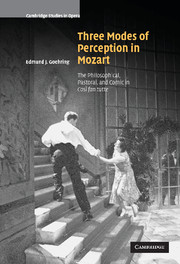Book contents
- Frontmatter
- Contents
- List of tables
- Preface and acknowledgments
- A note on translations
- List of abbreviations
- Chapter 1 An overture to Così fan tutte: the poetics of the opera over two centuries
- Chapter 2 The philosophical mode
- Chapter 3 The pastoral mode
- Chapter 4 The comic mode
- Epilogue
- Bibliography
- Index
Chapter 4 - The comic mode
Published online by Cambridge University Press: 22 September 2009
- Frontmatter
- Contents
- List of tables
- Preface and acknowledgments
- A note on translations
- List of abbreviations
- Chapter 1 An overture to Così fan tutte: the poetics of the opera over two centuries
- Chapter 2 The philosophical mode
- Chapter 3 The pastoral mode
- Chapter 4 The comic mode
- Epilogue
- Bibliography
- Index
Summary
INTRODUCTION: DON ALFONSO AS COMEDIAN
Così fan tutte's odyssey of deception and discovery begins with the fifth number, Don Alfonso's “Vorrei dir” (example 4.1). The cavatina must have struck an opera-enthusiast attending opening night as oddly familiar. As recently as two days before the premiere (and on seventeen earlier occasions during the Burgtheater's 1789–90 season), one could have heard the peasant Lilla, the heroine from Martín's Una cosa rara, sing a plea for rescue from a forced and unwanted marriage in similar strains (example 4.2). In matters great and small — from key (a relatively uncommon one at the time) and dimensions to rhythmic profile — the two numbers are so similar that Mozart's cavatina can legitimately be seen as a quotation of Martín's original.
Mozart's crib of Martín is obviously an ironic gesture. The central interpretive question involves identifying the source and purpose of this irony. I would suggest that no signs of sabotage appear in the music or words themselves, which instead skillfully reproduce the language of sentimental distress. In Da Ponte's text, for example, the alliterative stuttering of the line “Balbettando il labbro va” appropriately captures the physiological break-down induced by an abundance of sentiment. Where feeling is strong, after all, language must be weak. Appositely awkward, too, are Don Alfonso's clunky ottonari tronchi: it is as if there were another syllable that could not quite clear his throat. By contrast, some German adaptations of the work turn the number into farce.
- Type
- Chapter
- Information
- Three Modes of Perception in MozartThe Philosophical, Pastoral, and Comic in Cosí fan tutte, pp. 197 - 273Publisher: Cambridge University PressPrint publication year: 2004



